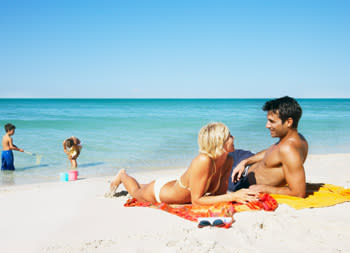Seven summer myths debunked

By Sarah B. Weir
We busted these top summer myths to help you stay safe and have fun all season.
Myth #1: Don't go in the water for at least 30 minutes after eating.
Busted: Despite what your mother might have warned you, neither the American Red Cross nor the American Academy of Pediatrics includes this old wives' tale in their water safety recommendations. It is true that more blood flows from the extremities to the gastro-intestinal tract immediately after eating, but the effect on recreational swimmers' performance is minimal.
Much more important rules to live by: Don't swim alone, never let a child be unsupervised in or near water, and do not swim after consuming alcohol.
Myth #2: A sunscreen with SPF 30 provides double the protection of SPF 15.
Busted: According to the American Academy of Dermatology, sunscreen protection does not increase proportionally with SPF rating. Applied properly, SPF 15 blocks 93% of UVB (burning) rays and SPF 30 blocks 97% of UVB rays.
Sunscreens above SPF 50 block about 98% of UVB rays, a negligible benefit, and may give people a false sense of safety about staying in the sun longer. SPF ratings do not measure protection against UVA rays - the rays that are responsible for skin cancer and visible signs of aging. The best advice: Use a broad-spectrum sunblock of SPF 30+ and reapply often.
Myth #3: If you are stuck outside in a lighting storm, lie flat on the ground.
Busted: Lighting storms create electrical ground currents so you can be electrocuted while lying on open ground even a hundred feet from where the lightning first strikes.
The safest place to be in a lightning storm is inside a building or a fully enclosed vehicle. Do NOT seek shelter in a storm under a tree - tall, pointy objects attract lightning. Lightning is one of the top three weather-related killers in the United States annually. If you hear the rumble of thunder, seek safe shelter immediately.
Myth #4: Going in and out of air-conditioned buildings can make you sick.
Busted: Sudden temperature changes may not feel comfortable but they do not cause illness. The common cold and flu are caused by viruses spread from infected to healthy individuals through physical contact, unclean surfaces, and airborne germs disseminated by a cough or sneeze. It's possible that those "summer cold" symptoms are actually being caused by seasonal allergies.
Myth #5: All sunglasses protect your eyes from the sun's harmful rays.
Busted: You might want to reconsider those dollar-store cheapies, because not all sunglasses are created equal. The sun's UV rays can cause short- and long-term damage to the lens and cornea of the eye and lead to cataracts and even eye cancer.
To ensure adequate protection, buy sunglasses that block 99-100% of UV rays or are labeled "UV400." Bigger is better - choose oversized or wrap-around styles that let in a minimum of light around the sides. Kids especially need UV rated sunglasses to protect their sensitive eyes.
Myth #6: To thwart a shark attack, punch or kick the shark directly in the nose.
Busted: Of the 50 or so unprovoked shark attacks on humans each year, the vast majority of these occur in North American waters. In the unlikely event you face off with a man-eater, it is more effective to claw, hit, or kick at the shark's sensitive eyes or its gills than its snout. The Florida Museum of Natural History offers sound advice on how to avoid shark-infested waters.
Myth #7: During a hurricane, open windows on the downwind side of a house to relieve pressure and prevent wind damage.
Busted: The National Weather Service (PDF) points out that hurricane winds shift constantly and your aim should be to keep wind and rain out of a house. Taping windows won't help either. Instead, the NWS recommends reinforcing exterior windows with plywood and evacuating the area if directed to do so by officials.
